Far-right parties have made significant gains in the EU elections, winning the vote in France and performing well in Germany and other countries, in results that will help tilt the European parliament towards a more anti-immigration and anti-green stance.
An initial projection by the European Parliament suggested that far and hard right groups were on course to win more than 160 seats out of a total 720 lawmakers in the next parliament, up from at least 135 last time.
The centre-right EPP was on track to win 181 seats, with the Socialists and Democrats in second place with 135 seats and the liberal Renew group 82 seats, holding on to third. The Greens are set to be the biggest losers falling from 71 seats in 2019 to 53, the estimates show.
The French Rassemblement National party led by Marine Le Pen was expected to have come first with around 33 per cent of the vote, according to exit polls on Sunday, in a stinging rebuke to the centrist alliance of president Emmanuel Macron that secured around 15 per cent of the vote.
“This result is emphatic. Our countrymen have expressed a desire for change and a path for the future,” said Jordan Bardella, who led the far-right RN’s campaign list.
In Germany, the three parties in Olaf Scholz’s coalition were all overtaken by the far-right Alternative for Germany (AfD), which came in second, behind the conservative CDU/CSU opposition. Ultraconservative and nationalist parties also won or made significant gains in Austria, Cyprus, Germany, Greece and the Netherlands, the exit polls showed.
“Kiss goodbye to the European Green Deal,” said Simon Hix, politics professor at the European University Institute in Florence, referring to the ambitious plan to hit net zero emissions by 2050.
“This is a pro-farmer, pro-car industry majority.”
He said the centre right European People’s Party of European commission president Ursula von der Leyen had become even more powerful, since it could work with parties to its left or right.
But the surge, at the expense of liberal and Green parties, would complicate von der Leyen’s bid for a second term as head of the EU’s executive.
The AfD defied recent scandals to take second place in Germany with 16.4 per cent of the vote. It was one of the AfD’s best results in a nationwide election, although lower than the 22 per cent share polls suggested in January.
“This is a super result . . . a record result,” said party co-leader Tino Chrupalla. “Our voters remained loyal to us and we beat the party of the chancellor, the Greens and the liberals.”
Its success came despite a flurry of negative headlines, many of them concerning its lead candidate in the election, Maximilian Krah. His staffer was arrested on suspicion of spying for China, and he sparked outrage by downplaying the crimes of the SS. The number two on the AfD’s list is meanwhile being investigated for corruption.
The result was a disaster for the three parties in Scholz’s fragile coalition — the Social Democrats (SPD), Greens and the liberal FDP. The Greens saw their share of the vote slump by more than 8 percentage points while the SPD garnered just 14 per cent — its worst-ever result in a nationwide vote.
The opposition centre-right CDU-CSU won the election with 29 seats, the SPD won just 14, the Greens 12 and the FDP 5.
In the Netherlands, Geert Wilders’ far-right Freedom party (PVV) won 7 seats, up from 1 last time, although that gave it slightly fewer seats than a Labour/Green party alliance.
The EPP performed strongly in Germany, Spain, Greece and some other countries, the data forecast.
“We are once again the strongest force in Germany,” von der Leyen said in response to the early projections from her home country. “Today we celebrate. From tomorrow we will continue working.”
To secure a second term as commission president, von der Leyen needs a majority of the 720-seat parliament to back her. Final results are expected early on Monday.
Additional reporting by Laura Dubois in Brussels



































